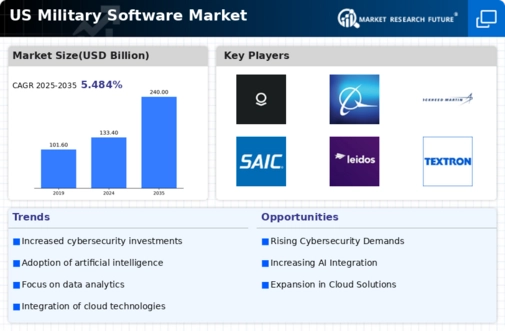Rising Defense Budgets
The military software market in the US is experiencing growth driven by increasing defense budgets. The US government has allocated substantial funds to enhance military capabilities, with a projected budget of over $800 billion for fiscal year 2026. This financial commitment is likely to bolster investments in advanced software solutions that improve operational efficiency and combat readiness. As military operations become more complex, the demand for sophisticated software tools that support logistics, training, and mission planning is expected to rise. Consequently, software developers are focusing on creating innovative solutions tailored to meet the evolving needs of the armed forces. This trend indicates a robust market environment where military software solutions are prioritized, ensuring that the military remains technologically advanced and prepared for future challenges.
Emphasis on Data Analytics
The sector is increasingly influenced by the emphasis on data analytics. The ability to process and analyze vast amounts of data is crucial for decision-making in military operations. As the US military seeks to leverage big data for strategic advantages, software solutions that offer advanced analytics capabilities are in high demand. This trend is reflected in the growing investments in software that can integrate data from various sources, providing actionable insights for commanders. The military's focus on data-driven strategies suggests that software developers must prioritize analytics features in their offerings. This shift not only enhances operational effectiveness but also positions the military software market as a critical component in the broader defense ecosystem.
Focus on Interoperability Standards
The sector is increasingly shaped by the focus on interoperability standards. As military operations often involve collaboration among various branches and allied forces, the need for software that can seamlessly integrate with different systems is paramount. The US military is actively pursuing initiatives to establish common standards that facilitate interoperability, which in turn drives demand for compliant software solutions. This trend suggests that software developers must prioritize creating products that adhere to these standards, ensuring compatibility across platforms. The emphasis on interoperability not only enhances operational efficiency but also strengthens alliances, making it a critical driver in the military software market.
Integration of Simulation Technologies
The sector is witnessing a surge in the integration of simulation technologies. These technologies are essential for training personnel and preparing them for real-world scenarios without the associated risks. The US military has recognized the value of simulation in enhancing readiness and has invested significantly in software that supports virtual training environments. This investment is likely to continue, as simulations provide cost-effective solutions for training large numbers of personnel. Furthermore, the ability to simulate complex combat situations allows for better preparedness and strategic planning. As a result, the demand for advanced simulation software is expected to grow, reinforcing its importance within the military software market.
Advancements in Communication Technologies
The sector is significantly impacted by advancements in communication technologies. As the nature of warfare evolves, the need for secure and reliable communication systems becomes increasingly vital. The US military is investing in software solutions that enhance communication capabilities, enabling real-time data sharing and coordination among units. This trend is reflected in the growing demand for software that supports secure messaging, video conferencing, and data transmission. The integration of advanced communication technologies into military operations is likely to enhance situational awareness and decision-making processes. Consequently, the military software market is expected to expand as developers create innovative solutions that address these communication challenges.

















Leave a Comment